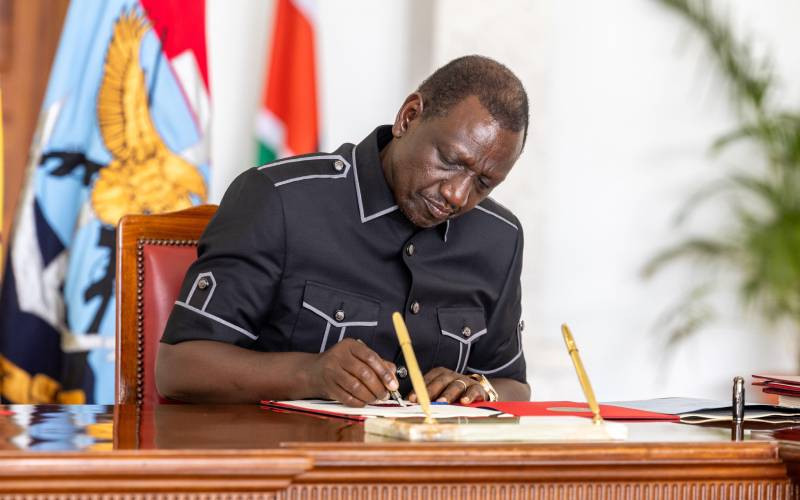Kenya: President Uhuru Kenyatta and Deputy President William Ruto read from the same page, earlier this week, when they appealed for the development of a skilled workforce to run the local and continental economies in a manner that makes them globally competitive.
Interestingly, although the two leaders were addressing different audiences, their message was the same. Analysts see this unity of vision — and purpose — as Kenya’s current key competitive edge particularly when it is viewed against the backdrop of the immediate past administration whose members thrived on public disagreements.
The consensus among development economists is that the entire country’s leadership should listen to divergent views, process them and then swiftly implement the best from all sides. That is the only way the country — and the continent at large — will reap the bulge dividend. The dividend is a result of the fact that our populations are growing even at the average age of their members is reducing at a time when other continents’ populations are growing older and fewer.
While opening the Africa Forum on Inclusive Economies at Windsor Golf and Country Club, President Kenyatta was clear that as “we develop our future workforce, we must start thinking more broadly about our educational investments that will cement our growth in years to come and that there is need for African countries to focus on engineering skills to run drilling operations, legal skills to negotiate positions that protect present-day assets into the future and technology skills that run the digital networks that are needed to monitor operations.”
Contextualizing the broad perspectives when opening Kenyatta University’s Camp-line and Directorate complex, Deputy President Ruto was emphatic that “universities have a role to play in ensuring Vision 2030 development blueprint becomes a reality.” The Deputy President challenged universities to identify the needs of the economy and come up with relevant programmes that meet those needs.
Data released from the International Maritime Organisation showing there was a supply requirement of 498,000 seafarers in 2008 with an officer shortfall of 34,000 which increased to 83,900 in 2012 is a stark indictment of the Ministry of Education whose top officials are careerists some of whom were on the job when the crisis was brewing. The sad reality is that many of them were too pre-occupied with petty personal and official issues and neglected the long-term issues emerging from the local and international labour markets.
Of course, to be fair to them, the constant din from the never-satisfied teachers unions even when their members are earning more than their civil service counter-parts and even much more than their former colleagues employed in the private sector does not make the educational mandarins’ jobs any easier. But still, they must find the time to synchronize what is taught in schools and colleges with the realities emerging from the labour markets.
Otherwise, they, and the institutions they oversee, soon change from being engines of economic growth into its breaks. Lower down the value chain, an issue that should put to shame every university administration is that they are graduating students every year into a job market in which they are not prepared to fit forcing some employers to spend huge sums of money and time re-training employees who were supposed to be already trained in, at least the basic skills for which they hold degrees. Needless to say, the majority of graduates lack communication and emotional intelligence skills which are vital in all work environments. The students graduating from the country’s high schools and tertiary colleges do not fare much better.
Galana Irrigation
This is why Housing Finance deserves a special commendation and support for setting up a foundation whose vision is “to deliver, facilitate and catalyze industry relevant and sustainable practical skills required by the building and construction industry”. Since the best form of flattery is imitation, the hope is that other key industry players will get together and come up with similar initiatives.
But, because the private sector’s ethos of profit-making might stand in the way of responding quickly to what is clearly a national crisis, the government should follow-up the words from both the President and Deputy President by crafting a mechanism that will do what needs to be done and then invite industry to join. Analysts are unanimous that such projects would easily attract additional funding from development partners.
Perhaps, the government might also be interested in looking at the pros and cons of starting a National Youth Service (NYS) scheme for university students desirous of enhancing the skills that would land them good paying jobs. Although the new NYS would be modeled along the lines of the existing one, it would differ in that it might be necessary for the government to set up whole new industries to offer the volunteer servicemen and women practical skills and future employment because the current industries might not have the capacity to absorb the huge numbers emerging from institutions of higher learning. These quasi-government industries would provide ideal training grounds for youth drawn from both services.
The charter setting up these companies would also specify the stage at which the profitable entities would be sold off to the public through the Nairobi Stock Exchange. A sector that quickly comes to mind as one where this approach could be tried and tested is the textile industry. The planned re-location of an American apparels company from China to Kenya that is expected to employ over 30,000 staff provides an opportunity the government could seize.
A government-owned, but privately-run, company could grow the cotton on the Galana Irrigation Project and process the yarn up to the cloth level. A subsidiary of the same company could then process the cotton seed into cooking oil and animal feeds.
Stay informed. Subscribe to our newsletter
 The Standard Group Plc is a
multi-media organization with investments in media platforms spanning newspaper
print operations, television, radio broadcasting, digital and online services. The
Standard Group is recognized as a leading multi-media house in Kenya with a key
influence in matters of national and international interest.
The Standard Group Plc is a
multi-media organization with investments in media platforms spanning newspaper
print operations, television, radio broadcasting, digital and online services. The
Standard Group is recognized as a leading multi-media house in Kenya with a key
influence in matters of national and international interest.
 The Standard Group Plc is a
multi-media organization with investments in media platforms spanning newspaper
print operations, television, radio broadcasting, digital and online services. The
Standard Group is recognized as a leading multi-media house in Kenya with a key
influence in matters of national and international interest.
The Standard Group Plc is a
multi-media organization with investments in media platforms spanning newspaper
print operations, television, radio broadcasting, digital and online services. The
Standard Group is recognized as a leading multi-media house in Kenya with a key
influence in matters of national and international interest.







